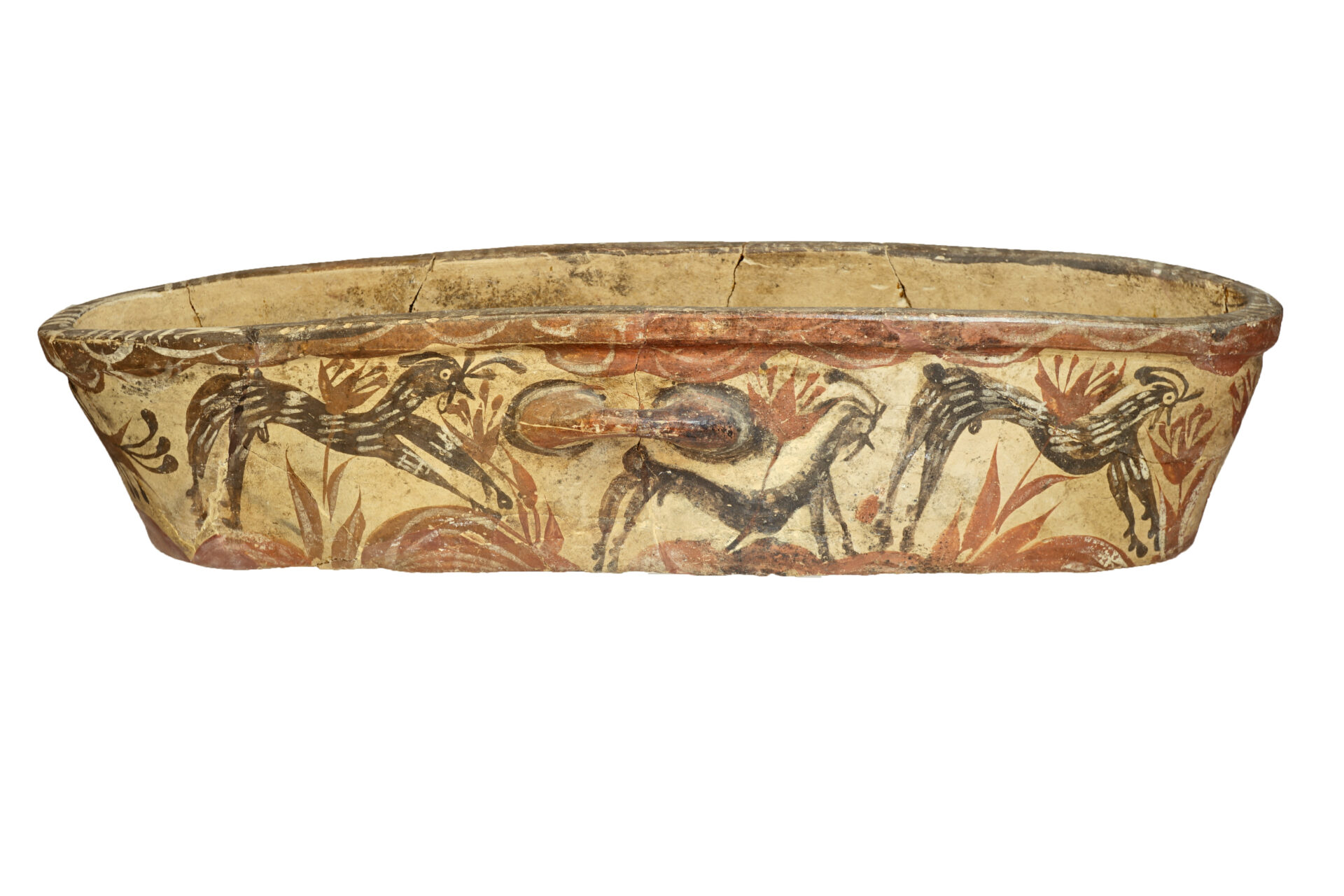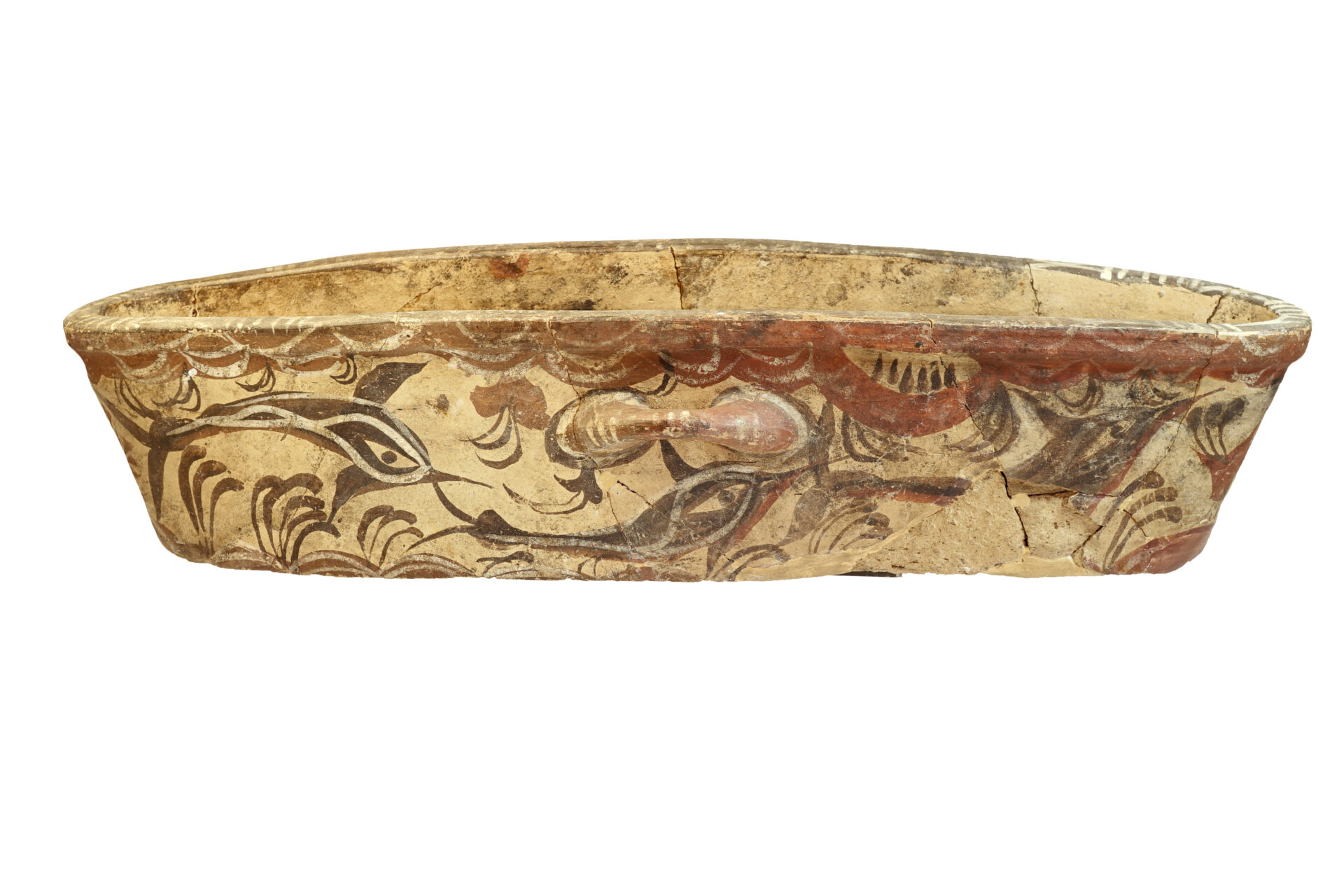Exhibit of the month
The entire world on an empty vessel…
A kymbe [1] of polychrome ware, depicting wild goats, dolphins and crocuses
Hellenic National Archaeological Museum
Collection of Prehistoric Antiquities Inv. Nr. Π27575 (ΑΚΡ 3266)
Provenance: Thera, Akrotiri, “House of the Ladies”, Room 7
Dimensions: length: 0,534 m., width: 0,139 m., height: 0,121 m.
Date: beginning of 16th cent. BC
Displayed: Exhibition of Theran antiquities, Gallery 48, Showcase 12
On one side of the vessel, three male wild goats are depicted in a rocky landscape among disproportionately large crocuses, which the animals are sniffing. The fur of two of the animals is rendered with white horizontal brushstrokes on a brown base. On the other side, three dolphins swim vividly in a marine landscape among rocks, sea vegetation, and waves. The plain interior of the vessel indicates that it was meant to remain unseen. It was found in the significant prehistoric settlement at Akrotiri, Thera, in the so-called “House of the Ladies”, a building of both residential and ritual character.
The use of the vessel is unknown to us, but the rarity of the type[2], the special shape, and its naturalistic decoration, which includes only wild goats, swallows, dolphins, lilies, and crocuses, suggest that it was used in specific -possibly ritual- circumstances of the life of the inhabitants at Akrotiri. The inclusive combination on this particular vessel of the emphatically male land animals, the strong and intelligent sea creatures, and the most symbolically charged plant, the crocus, strengthens the possibility of a religious character of the depiction.
The three most popular animals in the decoration of Theran pottery, which were likely inspired by the wall paintings of the period, are the wild goats, dolphins, and swallows, which are always shown in motion. A kymbe with a similar decoration of three wild goats among crocuses and three dolphins among the waves comes from Room 5 of the West House and is now kept in the Museum of Prehistoric Thera. The emphasis on the motif of triads and on trinitarianism, well-established in Egypt and the eastern Mediterranean, is not unknown in prehistoric Aegean (triads of divinities such as the “Ivory Triad” [3], flowers in groups of three in the Spring fresco [3], tripartite shrines), and is further reinforcing the connection to the religious sphere.
At Akrotiri, as in the entire prehistoric Aegean, humans live and interact harmoniously with the natural environment within a framework of respect. Beyond being a simple natural landscape, the environment is transformed through human experience into a social space, a symbolic space, and a mythological space. The lively wild goats, the giant crocuses, and the playful dolphins on the kymbe from Akrotiri are much more than a simple decorative depiction inspired by nature: they represent the viewing and perception of the landscape and wildlife by the inhabitants of Thera, integrating it into their daily, symbolic, and religious life and their ideological universe, possibly in myths and stories unknown to us. Although absent from the kymbe, humans are implicitly present as parts and spectators of the natural world, as artists and users of the vase, and as creators of the web of ideas expressed by the lively and dynamic scenes on the two sides of the vessel.
[1] The kymbe is a characteristic creation of Theran pottery, and its shape is not found anywhere else in prehistoric Aegean. It is an elongated, shallow vessel with rounded ends and two handles on its long sides.
[2] Only eight kymbae have been found to this day, all of them at Akrotiri. Three are presented in the permanent exhibition of Theran antiquities in the Hellenic National Archaeological Museum. Apart of the present kymbe, the visitors may admire two more vessels of the same shape in the permanent exhibition of Theran antiquities of the National Archaeological Museum, one kymbe decorated with dolphins (Inv. Nr. Π27379) and another one decorated with lilies (Inv. Nr. Π27427).
Katerina Kostanti
Bibliography
Marinatos, Sp. Excavations at Thera, VI-VII.1972-1973 Seasons. The Archaeological Society at Athens Library No 180. Athens 1999, 2nd Ed., 10-11, Pl. 80, Colour Plate 11.
Marthari, M. 1987. The Local Pottery Wares with Painted Decoration from the Volcanic Destruction Level of Akrotiri, Thera. AA 1987.3, 359-380.
Murray, S. P. 2004. Reconsidering the Room of the Ladies at Akrotiri, in Chapin, A. P. (ed.) Χάρις: Essays in Honor of Sara A. Immerwahr, Hesperia Supplement 33, Princeton, N. J.: The American School of Classical Studies at Athens, 101-130.
Κομνηνός, Π. 2011. Το τοπίο στις προϊστορικές τοιχογραφίες. Αιγαίο και Ανατολική Μεσόγειος (1700-1300 π.Χ.), Εκδοτικός Οίκος Σταμούλη.
Kriga, D. 2014. Flora and Fauna Iconography on Strainers and Kymbai at Akrotiri: Theran Ceramic Vessels of Special Use and Special Iconography στο Touchais, G., Laffineur, Ρ. and F. Rougemont (eds), Physis: l’environnement naturel et la relation homme-milieu dans le monde égéen protohistorique. Actes de la 14e Rencontre égéenne internationale, Paris, Institut National d’ Histoire de l’ Art (INHA), 11-14 Décembre 2012, Aegaeum 37, Leuven and Liege: Peeters, 499-503.



